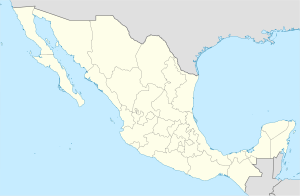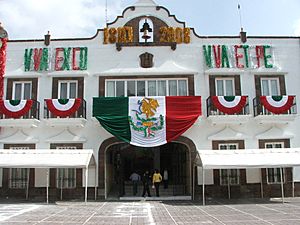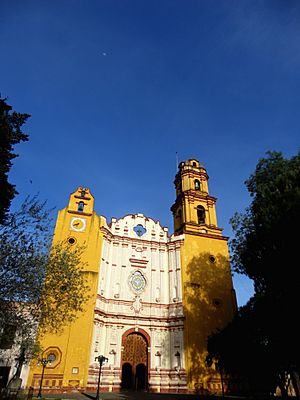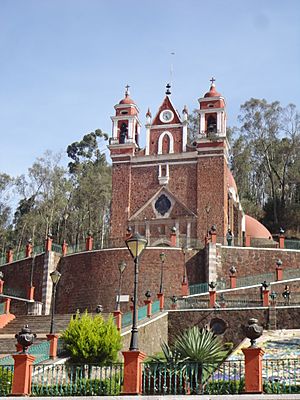Metepec facts for kids
Quick facts for kids
Metepec
|
||
|---|---|---|
|
Municipality and City
|
||
| Municipio de Metepec | ||
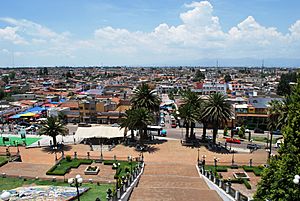
Panoramic view of Metepec
|
||
|
||
| Country | ||
| State | State of Mexico | |
| Founded | 1526 | |
| Municipal Status | 1848 | |
| Area | ||
| • Municipality | 70.43 km2 (27.19 sq mi) | |
| Elevation
(of seat)
|
2,620 m (8,600 ft) | |
| Population
(2005) Municipality
|
||
| • Municipality | 206,005 | |
| • Seat | 164,182 | |
| Time zone | UTC-6 (Central (US Central)) | |
| • Summer (DST) | UTC-5 (Central) | |
| Postal code (of seat) |
52140
|
|
Metepec is a city and a municipality in the State of Mexico, Mexico. It is located just east of Toluca, the state capital. Metepec sits high up, about 2,635 meters (8,645 feet) above sea level. Mexico City is about 50 kilometers (31 miles) to the east. Metepec is also part of the larger Greater Toluca area.
The name Metepec comes from the Náhuatl language. It means "hill of the agave plants". But it also has names in other local languages. In Matlatzinca language, it's "Nepinta-Tuhi," meaning 'people of corn land'. In the Otomi language, it's called "Ntaguada."
Contents
Exploring the City of Metepec
The city center of Metepec is at the base of the hill that gives it its name. People have lived here for a very long time. The Otomis and Matlatzincas settled in this part of the Toluca Valley. The Matlatzincas were a strong culture between 1120 and 1450 AD. Later, the Aztecs took over this area around 1470 AD. The Spanish arrived in 1526 AD. They built a church on the "maguey hill," which is now called the Ex-convento de San Juan. The Spanish then renamed the area San Juan Bautista Metepec.
Important Buildings and Festivals
The Ex-convento de San Juan is the main church in Metepec. It was built in the 16th century. Other old churches you can visit include Las Capillas de El Calvario and La Santa Cruz. Metepec celebrates its patron saint, John the Baptist, every year on June 24th. Since 1990, the city has hosted an international arts and culture festival called Quimera every October. It's a great time to see different kinds of art and performances.
The Cerro de Maguey, or Maguey Hill, has small caves. One is even called "La cueva del diablo" (The Devil's Cave). You can explore these caves. Metepec has typical regional food like barbacoa (slow-cooked meat), tamales, and huaraches (a type of thick tortilla). But it also has a special drink called "Garañona." This strong, sweet drink is made from 15 different herbs. You can only buy it at a bar called "2 de Abril" in the city center.
Metepec's Economy and Crafts
Metepec is very famous for its pottery. This craft is still very important for the local economy. Artisans here have formed groups like the Asociación de Artesanos de Metepec to support each other. They make things from clay, glass, and even leather. There are about 300 craftspeople and 275 family workshops in the city.
The most famous craft from Metepec is the Arbol de la vida ("Tree of Life"). This is a traditional pottery sculpture that shows the story of Adam and Eve. Mondays are market days in the city center, called the plaza. Merchants sell fresh fruits, vegetables, and even electronics there.
In recent years, Metepec has grown a lot. Many shopping malls, commercial centers, and car dealerships have been built. Some well-known places you can find here include:
- Walmart
- Sam's Club
- Costco
- Sears
- Liverpool (store)
- Chedraui
- Soriana
- McDonald's
- Burger King
- Cinemex
- Cinepolis
In 2005, the city of Metepec had about 164,182 people living there. The whole municipality had a population of 206,005. The municipality covers an area of 70.43 square kilometers (27.19 square miles). Most of the business activity happens in the city of Metepec itself.
The Municipality of Metepec
The city of Metepec is the main town of the municipality. This means it is where the local government is located. The municipality includes several smaller communities. Some of these are San Bartolomé Tlaltelulco, San Gaspar Tlahuelilpan, and San Miguel Totocuitlapilco.
The Metepec municipality shares borders with other municipalities like San Mateo Atenco and Toluca. Because it is so high up, the weather in Metepec is usually mild. Temperatures are often between 14 and 30 °C (57 and 86 °F). Sometimes it can get very cold, even down to -5 °C (23 °F), as late as March or April.
Economic Activities in the Municipality
Outside of the main city of Metepec, farming is still a very important activity. A large part of the land is used for growing crops. There are also fish farms. Farmers raise animals like cattle, sheep, pigs, and chickens. Most of these animals are raised for families to eat or to sell in nearby towns.
However, factories and industries are also growing in importance. There are businesses that process food, bottle drinks, make clothes, and produce building materials. This shows how the economy of Metepec is changing and growing.
History of the Municipality
During the Spanish Conquest, Spanish soldiers and their allies took over many towns in this area, including Metepec. The native people sometimes left their lands. These lands were then given to the Spanish soldiers and local chiefs who helped them. The lands around Metepec were given to Captain Juan Gutiérrez Altamirano. He brought the Franciscans to teach Christianity to the people.
By 1560, Metepec was an important administrative center. The municipality of Metepec was officially created in 1821. This was later confirmed by the government of the State of Mexico in 1827.
Education in Metepec
Metepec has many schools and universities. Here are some of them:
- Instituto Universitario Verdad y Ciencia
- Instituto Cumbres
- Colegio Nuevo Continente - Campus Metepec
- Universidad del Valle de Mexico Campus Toluca
- Instituto Cenca S.C.
- Universidad Autónoma del Estado de México
- Instituto Tecnológico de Toluca
- Instituto Tecnológico de Estudios Superiores de Monterrey (Campus Estado de México)
- Instituto Tecnológico de Estudios Superiores de Monterrey (PrepaTec Metepec)
- Colegio Argos
Sister Cities
Metepec has special friendships with other cities around the world. These are called "sister cities."
- Tlaquepaque, Jalisco, Mexico
- Villanueva de la Cañada, Madrid, Spain
- Trujillo, La Libertad, Peru
See also
 In Spanish: Municipio de Metepec (Estado de México) para niños
In Spanish: Municipio de Metepec (Estado de México) para niños



